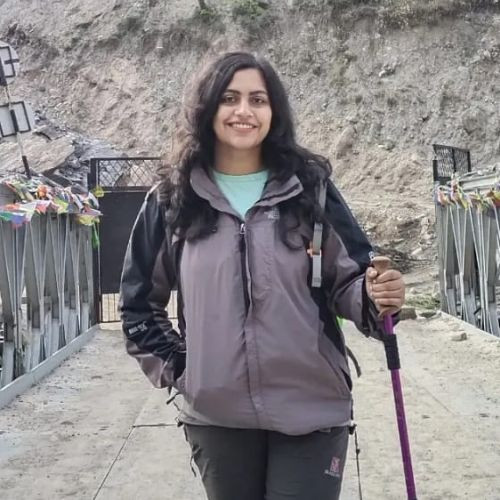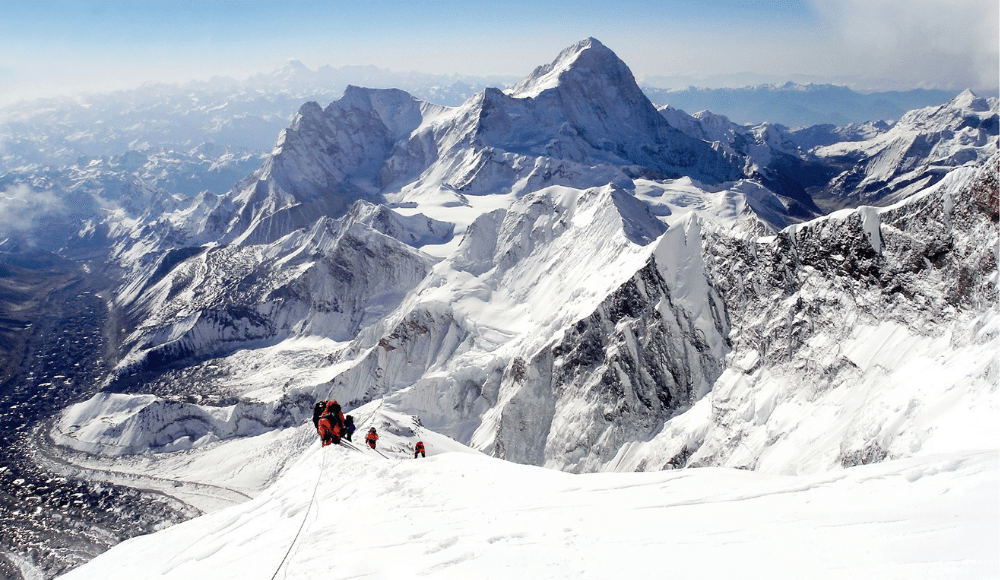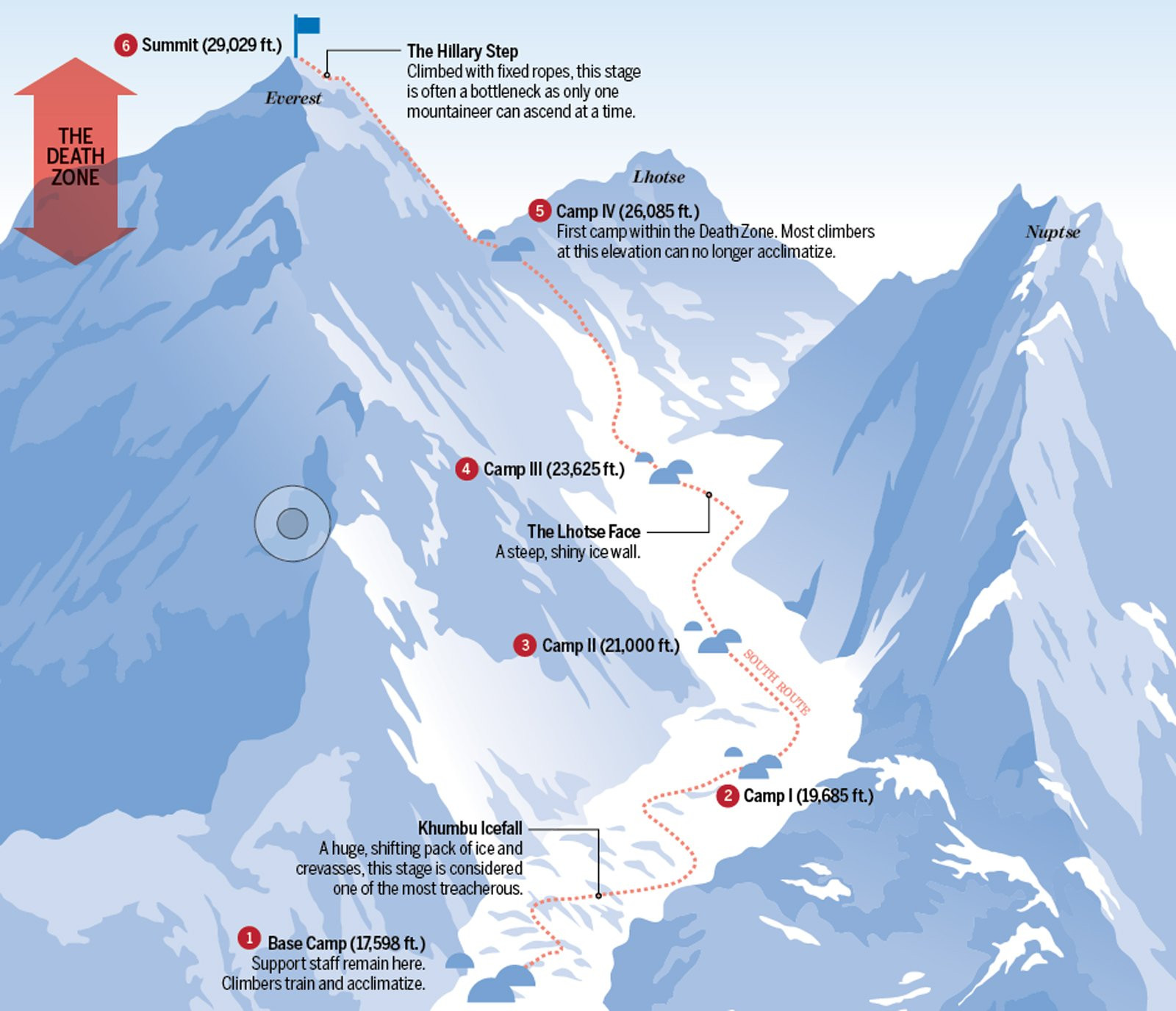Mount Everest Rainbow Valley
Rainbow Valley of Mount Everest - A colorful yet tragic valley!
Rainbow Valley of Mount Everest - A colorful yet tragic valley!


Although climbing Mount Everest seems extremely risky and is something that every high-altitude climber hopes to accomplish at least once, in their lives, there is a dark side to the mountain that is frequently ignored. The climbers are reminded by the bodies to remain focused and vigilant at all times while ascending the death zone. The rainbow valley is a part of a landmark during the Everest Expedition full of dead bodies of climbers.
When you hear the name Mount Everest Rainbow Valley, the first thing that comes to mind is certainly a vision of a lovely location, likely one that is vibrant, bright, and teeming with life. In contrast to these preconceptions, Mount Everest Rainbow Valley is absolutely unique. In actuality, Mount Everest's Rainbow Valley serves as the mountain's cemetery, housing the remains of climbers who died either while attempting to reach the summit or while descending to their base camps.
The many people who pass away while climbing Mount Everest's side still wear the vibrant pattern of down winter coats that can be seen there. As you ascend, it is common to pass a frozen corpse because they are trapped in time. Corpses can survive for decades in the extreme circumstances of fatal heights, with some seeming frozen in time with climbing equipment still attached.
A climber can plummet straight to the Rainbow valley if they make an inch-sized mistake on the way to the Everest summit of over 8000 meters. And yes, the area of colorfully-clad dead climbers on the northern lower side of the Everest summit is known as Rainbow Valley Everest. Every climbing enthusiast has Mount Everest on their bucket list. For all mountaineers, climbing the highest peak in the world is a fantastic adventure. The Everest trip is really difficult and includes a lot of sinister elements.
One such part of the climb is the Rainbow Valley of Mount Everest. Although it may seem like a lovely setting, the truth is quite the reverse. It is notorious for containing numerous bodies of Everest expedition members and is situated beneath Mount Everest's northern crest. The mountaineers call the area, which is located over 8000 meters, the "Death Zone."
"The road to Everest is not a Yellow Brick Road," said Krakauer. It is a really accurate proverb. But climbing to the top of the world is a goal of practically everyone, who may have even considered it.
Despite the fact that climbing Mount Everest is a dangerous and adventurous endeavor, numerous mountain climbers attempt it every year. Mount Everest has never failed to capture the attention of half of the mountaineers, despite the fact that they are all aware of the life-threatening death zone leading to the Rainbow Valley, which is an open graveyard for the unfortunate summiters.
It is a voyage full of a variety of feelings, inspiration, self-assurance, danger, adventure, and other endless feelings that one cannot articulate.
Despite being one of the world's most treacherous summits, Mount Everest's appeal has been rising quickly. The Himalayas are where Mount Everest is located. It is situated between the autonomous regions of Nepal and Tibet and is the highest peak in the world, rising to a height of 8848.86 meters.
The next path is from Tibet, while the southeast route comes from Nepal. The Mount Everest expeditions traveled the conventional path from the Nepal side of the Himalayas. Even if scaling Mount Everest requires a lot of bravery, it is still a challenging task.
Everest has long been on the bucket lists of many climbers and adventurers. When it took just one peak for more than ten years, Everest had its first successful expedition. A death rate of 14.1% is observed on Mount Everest. On the trek to Mount Everest, there is a one in a ten risk that you may die. In an autonomous area, climbing is a challenging endeavor.
In Mount Everest's death zone, numerous accidents happen frequently, and most people die after reaching the summit. Rainbow Valley is the final resting place of everybody who passes away there. One climber at a time can fit on the trail to the death zone, therefore there is simply no room for the body. Any climbers who die on the way to the death zone will be pushed off the trail by the other climbers, which eventually leads to Rainbow Valley.
In the valley, there are still several dead laying there. The colorful jackets worn by the dead bodies, which are still covered, are blue, red, orange, and green. Additionally, the area is filled with vibrant tents, bags, trash, cans, and oxygen tanks. The region is referred to as Mount Everest's Rainbow Valley because from a distance it appears to be a rainbow's worth of colors.
However, it costs tens of thousands of dollars and takes six to eight Sherpas, possibly placing their lives in peril, to return a body to a family.
The reality of the heart-shivering Death Zone - Where is it?
The term "death zone" refers to an area above 8,000 meters in altitude where there is so little oxygen that the body begins to perish, minute by minute and cell by cell. Climbers' brains and lungs are depleted of oxygen in the death zone, which further raises their risk of heart attack and stroke and rapidly impairs their judgment.
|
Reaching at Everest Base Camp (5364m, 17598ft) |
|
Crossing the Khumbu Ice Fall which is a huge shifting pack of ice and crevasses. |
|
Camp I (6065m, 19,685 ft) - visit several times to acclimatize from the base camp. |
|
Camp II (6600m, 21,000 ft) - few visits from camp 1 to acclimatize again. |
|
Crossing the Lhotse Face which is a steep, shiny ice wall. |
|
Camp III (7300m, 23,625 ft) - Summit push starts from here. |
|
Camp IV (7900m, 26,085 ft) which is the first camp with the death zone and it is the zone where acclimatization is no longer possible. |
|
Hillary Step - This step is climbed with fixed ropes and only one mountaineer can ascend at a time. |
|
Summit (8848.86m, 29,029 ft) - Top of the Mount Everest |
Climbers must cross the "death zone," the mountain's most perilous area, in order to reach Mount Everest's beautiful summit. Climbers must allow their bodies enough time to adjust to higher altitudes in order to prepare. Because of this, it typically takes them many weeks to conquer Mount Everest. Every few thousand feet, they pause to rest.
Simply put, the body will never allow you to spend more than 48 hours in the Death Zone since the oxygen level there is only one-third that at sea level. Because the oxygen level in the Death zone is only one-third that of the sea level, the body will quickly exhaust its supply of oxygen before respiration can replenish it.

Reduced appetite is a common symptom of altitude sickness, particularly HAPE and HACE. Snow blindness, or temporary loss of vision, can result from the brightness of the never-ending snow and ice, which can also cause ocular blood vessels to burst.
The bodies of climbers who perished in the Mount Everest Death Zone serve as a continual reminder that this is the most perilous part of the summit and that one careless move or incorrect calculation could result in their demise.
According to one statistic, one climber has perished on the way up or down for every ten who have successfully scaled the mountain.
According to Science Daily, "The first comprehensive examination of deaths during trips to the peak of Mt. Everest has been done by an international research team led by Massachusetts General Hospital (MGH) investigators. The majority of fatalities, they discovered, take place on descents from summits in the so-called "death zone" over 8,000 meters. They also discovered certain indicators that seem to be linked to a higher risk of mortality, specifically signs of high-altitude cerebral edema.
Captain MS Kohli claimed that climbing Everest "seems like a big joke today" in a BBC article. The first successful Indian expedition to the summit of Mount Everest was led by Captain MS, a well-known mountaineer from India, in 1965. He continues, "It certainly doesn't resemble the earlier days, when there were adventures, difficulties, and exploration. Simply said, it involves climbing with others' assistance.
No matter whether a climber is ascending or descending, being in the death zone is extremely risky. A person is more likely to be in danger the longer they remain in the death zone. If you stay there long enough, a climber will undoubtedly perish. People are more vulnerable during their descent since they have spent more time in the death zone by that point since a person descends after they have ascended.
As of right now, there are more than 200 dead bodies in the Rainbow Valley. Since the first expedition, bodies have been piling up in the Rainbow Valley. They are still being added to every day, and they won't stop until the Everest expedition is through.
With the beginnings of Everest expeditions, the Rainbow Valley Mount Everest was formed. The beginning of the Everest Expeditions resulted in numerous climbers dying on their expeditions as well, earning it the nickname "Death zone." Body parts either fall into the rainbow valley or are propelled forward by other climbers.
The death zone's passageway is so small that pushing the dead bodies becomes mandatory. The dead bodies are quite difficult to remove. They must be moved aside to create an area for the climbers. As a result, numerous climbers' bodies tumbled into Rainbow Valley on Mount Everest's slope.
Everest rainbow valley preserves some of the tragic incidents and has kept so many beautiful souls, which are following:
The story of a body known as "Green Boots" is among the most horrifying and well-known tragic tales from Mount Everest. Although the body's identity was unknown, Tsewang Paljor is thought to be the one.
The corpse is curled up in a limestone cave on Mount Everest's Northeast ridge trail and is known by the bright green hiking boots it is wearing. Despite being close to the summit, the path is still dangerous, and everyone who passes through is obliged to step over his legs.
Green Boots is thought to be Tsewang Paljor, a member of a four-man Indian climbing team who made their attempt to reach the summit in May 1996.
Tsewang Paljor was a member of the Indo-Tibetan Border Police and a native of the Himalayan village of Sakti. When he was chosen to be a member of the elite group that intended to be the first Indians to summit Everest from the north side, he was overjoyed. However, the outcome was terrible; he passed away there as a result of the Everest Disaster, and his body was found in Rainbow Valley Everest with green boots on.
The most well-known of the historical corpses is that of Green Boots, an Indian climber by the name of Tsewang Paljor who passed away more than two decades ago. The climber sleeps on his side as if taking a nap, in the shelter of an overhanging rock that has the appearance of a little cave.
He has tightly wrapped his arms over his torso to protect himself from the piercing wind and cold and pulled the red fleece up about his face to conceal it from view. Passersby must carefully step over Paljor's neon green climbing boots as his legs extend into the walkway.
Another famous dead body is that of Francys Arsentiev who became the first woman from the United States of America to reach the summit of Mount Everest without the aid of bottled oxygen, in 1998.
She died of frostbite and her husband died searching for her during the descent. The frostbite had distorted her face with blemished redness and had turned her skin hard and white. The effect gave Francys the smooth features of a wax figure and led to the remark that the fallen climber looked like Sleeping Beauty, a name the media eagerly seized for the headlines.
Francys Arsentiev set out in 1998 to climb Everest as the first American woman without the use of bottled oxygen. Together with her husband Sergei, she accomplished a remarkable achievement. However, they needed more oxygen to ascend, and by the time they started to descend, the weather had changed.
The first woman to die on Mount Everest was a German climber named Hannelore Schmatz in 1979. She and her company successfully ascended Mount Everest, but she became stranded going down. She slipped and died on her back during the chilly night. Schmatz's body was still on the ice, her eyes wide, and her hair blowing in the wind. Her body is still in the Rainbow Valley Everest even though she was carried away by strong winds.
The oldest body uncovered to date was discovered on Everest in 1999. 75 years after George Mallory's death in 1924—and during an abnormally warm spring—his body was discovered. Mallory had made an effort to ascend Mount Everest first, but he vanished before anyone could confirm if he had succeeded. In 1999, George's body was discovered; the upper torso, left arm, and part of his legs were all virtually entirely undamaged.
Conrad Anker, one of the famous mountaineers, discovered George's body while filming the historic meeting with a documentary team. George Mallory's name was sewed into a tag that served as the body's identification. Based on a broken leg bone, it appeared that he had fallen or slipped and had become helpless. High winds and weather had in some areas stripped the body of its clothes and skin, but the intense cold had otherwise kept it largely intact.
A mountaineer from New Zealand named Rob Hall served as the expedition's chief guide in 1996, when he, another guide, and the two mountaineers had their last breath on Mount Everest. Jon Krakauer's Into Thin Air, a best-selling account of the trip, and the 2015 movie Everest both dramatized the journey. Hall had just finished his fifth attempt to reach the peak of Everest when he passed away, which was a record for a non-Sherpa mountaineer.
Even if Hall had not lived, some of his squad had. For instance, Jon Krakauer featured Hall's experience in his book Thin Air after originally intending to write about the journey for Outside magazine. Krakauer is responsible for ensuring the survival of the account of Hall's trip.
Related Article: How long does it take to climb Mount Everest?
Any mountaineer's dream is to reach the summit of Mount Everest. The greatest sense of accomplishment and success can be found at the height of this peak. Everyone wants to see the globe from 8848 meters above sea level. But only a select group of adventurers manage to reach the peak of Everest, experience what it's like to be on top of the world and travel to its highest point. Everest Base Camp is the preparatory zone for Mount Everest Expedition.
Post-Mid-March, April, May, and mid-June are the ideal months to climb Mount Everest. In these months, a lot of climbers try to reach Everest's summit. The ideal months to climb Mount Everest are generally regarded as April and May.
You might believe that since it's summer, the period from mid-June to August is the greatest time to see Mount Everest. However, the rainy season will soon be here, and it will not be the best time to see Mount Everest. Mist envelops Mount Everest.
The weather will be pleasant and cool from Tibet's northern side during that time, making for the ideal setting for tourists. The greatest time to travel to Tibet and stroll around in order to see Mount Everest and catch a glimpse of it is during the summer.
September to November may herald a hard winter and provide a brief window during which to catch a glimpse. Visitors can view more throughout the autumn than they can during the spring. Warm days and chilly nights are more common from late September through early December.
However, the trip may have to stop in some places if the weeks or gaps are unpredictable because of the weather. The most crucial step in an excursion is waiting for the ideal moment to crawl on your feet.
our first-hand Himalayan travel experience